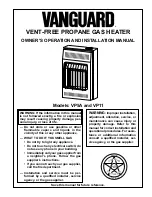
36
The anode rod should be inspected after a maximum of three
years and annually thereafter until the condition of the anode
rod dictates its replacement.
NOTE:
Artificially softened water requires the anode rod to
be inspected annually.
The following are typical (but not all) signs of a depleted
anode rod:
The majority of the rods diameter is less than 3/8”.
Significant sections of the support wire (approx. 1/3 or more
of the anode rod’s length) are visible.
If the anode rod show signs of either or both it should be
replaced. NOTE: Whether re-installing or replacing the anode
rod, check for any leaks and immediately correct if found.
To replace the anode:
1. Turn off electric supply to the water heater.
2.
Shut off the water supply and open a nearby hot water faucet
to depressurize the water tank.
3. Drain approximately 5 gallons of water from tank. (Refer
to “Draining and Flushing” for proper procedures). Close
drain valve.
4. Remove old anode rod.
5.
Use Teflon® tape or approved pipe sealant on threads and
install new anode rod.
6. Turn on water supply and open a nearby hot water faucet
to purge air from water system. Check for any leaks and
immediately correct any if found.
7.
Restart the water heater as directed in this manual. See the
Repair Parts Illustration for anode rod location.
FLUSHING THE WATER HEATER
1. Turn off the electrical supply to the water heater at the
breaker or disconnect switch.
2. Ensure the cold water inlet valve is open.
3. Open a nearby hot water faucet and let the water run until
the water is no longer hot. Then close the hot water faucet.
4. Connect a hose to the water heater drain valve and
terminate it to an adequate drain.
5. Ensure the drain hose is secured before and during the
entire flushing procedure. Flushing is performed with system
water pressure applied to the water heater.
6.
Open the water heater drain valve to flush the storage tank.
7. Flush the water heater storage tank to remove sediment
and allow the water to flow until it runs clean.
8. Close the water heater drain valve when flushing is
completed.
9. Remove the drain hose.
10.
Fill the water heater – see the Filling The Water Heater
section in this manual.
11. Turn on the electrical supply to the water heater.
12. Place the water heater back in operation. Allow the water
heater to complete several heating cycles to ensure it is
operating properly.
SEDIMENT REMOVAL
Water borne impurities consist of fine particles of soil and sand
which settle out and form a layer of sediment on the bottom of
the tank. In time, if not removed, the level of sediment might
reach the heating elements and cause their failure.
For convenience, sediment removal and element lime scale
removal should be performed at the same time as follows.
LIME SCALE REMOVAL
Lime scale accumulations on the heating elements is a normal
condition, common to all immersion type elements. Factors
which affect the amounts of this formation are:
1. Amount of hot water used. As the volume of water heated
increases, more scale results.
2.
Water temperature. As the temperature of the water is
increased, more scale is deposited on the elements.
3. Characteristics of water supply.
Regardless of water treatment, the elements should be
examined regularly.
Lime scale accumulations may cause noises to occur during
operation.
It is recommended that a heating element be removed
periodically for examination. If it is scaled, all of the elements
should be removed and cleaned. If the tank bottom has an
accumulation of sediment it should be cleaned.
Lime scale should be removed by dissolving the accumulation
in UN•LIME® delimer. Do not use muriatic or hydrochloric
acid base deliming solutions to remove lime scale from the
elements.
THE PROCESS FOR LIME SCALE REMOVAL IS AS FOL-
LOWS:
1. Turn off electrical disconnect switch.
2.
Drain the heater following DRAINING instructions.
3. Open front panel.
4. Disconnect the element wiring. Try not to disturb the wiring
unnecessarily and reconnection will be easier.
5.
Unscrew each element.
6. Remove the elements and gaskets from the openings.
•
Use a twisting, pulling action to remove elements scaled
beyond the size of the tank openings.
•
Brush loose scale from elements.
7. Lime scale removal:
•
Place limed ends of heating elements into UN•LIME
delimer and allow scale to dissolve. Do not permit
delimer or water to contac heating element electrical
terminals.
•
Silicates, sulfates, and aluminates must be removed
by scraping or other mechanical means. Lime scale
dissolvents will not remove these types of scale which
are occasionally encountered.
Call the toll free phone number on the back cover of this
Instruction Manual to purchase UN-LIME and heating element
gaskets.
Printed on 2/8/2018 9:05 AM CT
Содержание 52
Страница 8: ...8 FEATURES AND COMPONENTS Figure 2 Electronic Control Modules Printed on 2 8 2018 9 05 AM CT...
Страница 9: ...9 FEATURES AND COMPONENTS Figure 3 Surface Mount Control Models Printed on 2 8 2018 9 05 AM CT...
Страница 52: ...52 Copyright 2017 All rights reserved www hotwater com Printed on 2 8 2018 9 05 AM CT...
















































